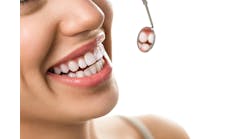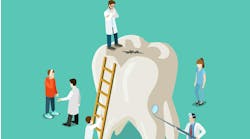Colleen Greene, DMD, MPH
As dentists, we manage risk every day. From protecting health information to preventing sharps exposures, we avoid danger carefully. With children, we must pay similar attention to weighing the risks and benefits when taking radiographs. Radiation affects rapidly growing cells the most and its effects can accumulate in tissue over time, so early exposures must be chosen carefully. Yet, avoiding radiation exposure due to concerns about behavior or parent preference may place a child at more risk from undiagnosed decay. We must be intentional, consistent, and prepared for challenges when prescribing pediatric dental radiographs.
There is significant variation in international guidelines about the initiation and frequency of radiographs, according to a 2017 article in the British Dental Journal.1 Dental developmental stage is more important than age in determining when a first image is necessary. This assessment requires careful clinical judgment. If a three-year-old patient with moderate plaque has tight posterior contacts, bitewings should absolutely be considered to assess interproximal decay. However, if a four-and-a-half-year-old patient presents with excellent oral hygiene and generalized positive spacing, it may be reasonable to defer imaging to the next exam.
Always complete a clinical exam first before determining whether radiographs are necessary. Make personalized decisions based on a valid caries risk assessment at each exam.2 Clinical signs or a history of decay is always the strongest caries predictor. Any cavitation on a smooth surface should raise your concern immediately for posterior decay. Newly closed posterior contacts mean a higher chance of interproximal lesions, even with minimal plaque upon exam or only light contacts. If you determine that a patient has a high caries risk, be ready to consider a six-month bitewing interval.3,4
If a child has a caries-free exam at two consecutive visits and you assess a low caries risk, there is wide variation in recommended radiograph frequency. The American Dental Association and the American Academy of Pediatric Dentistry support 12 to 24 months between bitewings for low-risk mixed-dentition patients, while other peer-reviewed articles suggest up to 36-month intervals.1,3,4 There is significant leeway for providers and parents to jointly decide on a time frame that works best for the patient.
When child cooperation makes getting a diagnostic film challenging, be prepared for an alternative approach. Failing to diagnose caries is a greater risk than a temper tantrum. For a high-risk child, especially one with visible cavitated lesions, it’s important to work toward high-quality radiographs even if there’s a struggle. Primary tooth enamel is thinner and pulp chambers are relatively large compared to permanent teeth, so caries can progress to pain or an abscess quickly.
Our teams need to feel confident in taking diagnostic images, especially for less-than-happy campers. Once you have determined your criteria for prescribing radiographs for children, it’s important that you communicate this clearly to your auxiliary staff.
Sometimes a knee-to-knee position with two adults wearing protective lead gowns is necessary. We use paper tabs or plastic bite sticks with ScanX phosphor plates (Air Techniques) in our office. If a team member is needed to assist hands-on, it may work to use a plastic bite stick to position a film and help the patient close tightly.
That said, this is a hard skill to master. Don’t forget the value of basic behavior guidance with your patients via tell-show-do, patience, and distraction. Mentoring from a pediatric dentist or another experienced provider may be key. Invest in learning how to effectively minimize your team’s imaging retakes. Consider inviting a local pediatric dentist to your study club or office to describe real-life tactics and scenarios in radiograph decision-making with young patients. Try to capture two bitewings instead of four periapicals for reluctant patients. Use the minimum thickness biting surface (paper tab versus plastic stick for phosphor plates) to maximize the actual diagnostic real estate on the image.
Be confident in your rationale for radiograph exposure with young patients. Do not sacrifice the quality of your exams by avoiding radiographs due to developmentally normal resistant behavior, especially if you are suspicious of carious lesions. Customize your approach to the individual child and an updated caries risk assessment at every exam. Build your behavior-guidance skills to help facilitate imaging and minimize the risk of undiagnosed cavities in the children of your practice.
References
1. Goodwin TL, Devlin H, Glenny AM, O’Malley L, Horner K. Guidelines on the timing and frequency of bitewing radiography: a systematic review. Br Dent J. 2017;222(7):519-526. doi: 10.1038/sj.bdj.2017.314.
2. Guideline on Caries-Risk Assessment and Management for Infants, Children, and Adolescents. Council on Clinical Affairs. Reference Manual. American Academy of Pediatric Dentistry. 2002;37(6):132-139. http://www.aapd.org/media/Policies_Guidelines/G_CariesRiskAssessment.pdf. Published 2002. Updated 2006, 2010, 2011, 2013, 2014. Accessed July 2, 2018.
3. Dental Radiographic Examinations: Recommendations for Patient Selection and Limiting Radiation Exposure. Council on Scientific Affairs. American Dental Association. https://www.ada.org/~/media/ADA/Publications/ADA%20News/Files/Dental_Radiographic_Examinations_2012.pdf?la=en. Updated 2012. Accessed July 2, 2018.
4. Guideline on Prescribing Dental Radiographs for Infants, Children, Adolescents, and Persons with Special Health Care Needs. Ad Hoc Committee on Pedodontic Radiology. Council on Clinical Affairs. American Academy of Pediatric Dentistry. 1981;37(6):319-321. http://www.aapd.org/media/Policies_Guidelines/E_Radiographs.pdf. Published 1981. Updated 1992, 1995, 2001, 2005, 2009. Accessed July 2, 2018.
Colleen Greene, DMD, MPH, a Harvard University dental graduate with a master’s in health management and policy, is a board-certified pediatric dentist and faculty member at Children’s Hospital of Wisconsin. She serves on the Wisconsin Dental Association Legislative Advocacy and Political Action Committees and the American Dental Association New Dentist Committee. She is Wisconsin’s Public Policy Advocate for the American Academy of Pediatric Dentistry and a fellow of the Pierre Fauchard Academy. Dr. Greene is a member of the Dental Economics Editorial Advisory Board.








